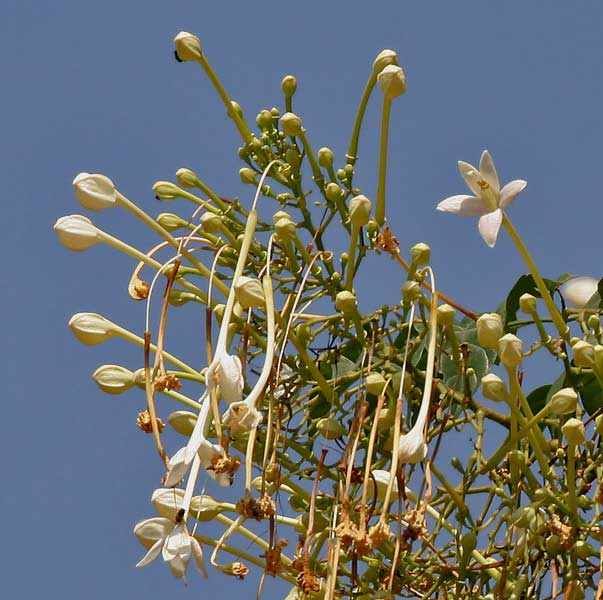
Millingtonia hortensis (Photo: *)
Classification System: APG IV
Superregnum: Eukaryota
Regnum: Plantae
Cladus: Angiosperms
Cladus: Eudicots
Cladus: Core eudicots
Cladus: Asterids
Cladus: Lamiids
Ordo: Lamiales
Familia: Bignoniaceae
Tribus: Oroxyleae
Genus: Millingtonia
Species: Millingtonia hortensis
Name
Millingtonia hortensis L.f., 1782
Synonyms
Homotypic
Bignonia suberosa Roxb., Pl. Coromandel 3: 11 (1811), nom. superfl.
Nevrilis suberosa Raf., Sylva Tellur.: 138 (1838), nom. superfl.
Bignonia hortensis (L.f.) Oken, Allg. Naturgesch. 3(2): 1009 (1841).
Heterotypic
Bignonia azedarachta J.Koenig, Ann. Bot. (König & Sims) 1: 578 (1805).
Bignonia cicutaria J.Koenig ex Mart., Denkschr. Königl. Akad. Wiss. München 6: 153 (1820).
Millingtonia dubiosa Span., Linnaea 15: 326 (1841).
Distribution
Native distribution areas:
Continental: Asie
China (S-Yunnan), Java, Myanmar [Burma] (widespread), Bangladesh, Thailand, Cambodia, Laos, Vietnam, Lesser Sunda Isl. (to Timor), S-Sulawesi.
References: Brummitt, R.K. 2001. TDWG – World Geographical Scheme for Recording Plant Distributions, 2nd Edition
References
Linnaeus, C. (filius) (1782) Supplementum Plantarum Systematis Vegetabilium Editionis Decimae Tertiae, Generum Plantarum Editiones Sextae, et Specierum Plantarum Editionis Secundae. Editum a Carolo a Linné. Brunsvigae [Braunschweig] 291. 1782 ("1781")
Links
Govaerts, R. et al. 2019. Millingtonia hortensis in World Checklist of Selected Plant Families. The Board of Trustees of the Royal Botanic Gardens, Kew. Published online. Accessed: 2019 Apr. 27. Reference page.
International Plant Names Index. 2019. Millingtonia hortensis. Published online. Accessed: Apr. 27 2019.
The Plant List 2013. Millingtonia hortensis in The Plant List Version 1.1. Published online. Accessed: 2019 Apr. 27.
Tropicos.org 2019. Millingtonia hortensis. Missouri Botanical Garden. Published online. Accessed: 27 Apr. 2019.
USDA, ARS, Germplasm Resources Information Network. Millingtonia hortensis in the Germplasm Resources Information Network (GRIN), U.S. Department of Agriculture Agricultural Research Service. Accessed: 07-Oct-06.
Vernacular names
中文: 老鸦烟筒花
Millingtonia hortensis, the tree jasmine or Indian cork tree, is the sole species in the genus Millingtonia,[2] is a tree native to South Asia & South East Asia.
In the name Millingtonia hortensis, Millingtonia is named for Sir Thomas Millington who was an inspiration to Carl Linnaeus the Younger who first described the genus.[3] The specific epithet 'hortensia' derives from 'hortensis' and 'hortus' which in Latin is related to garden. In its synonym, Bignonia suberosa, 'suberosa' derives from 'suberos' which means 'corky' in Latin.[4]
Millingtonia Avenue in Lucknow is named after Millingtonia hortensis.[5]
Description
The tree grows to height of between 18 and 25 metres and has a spread of 7 to 11 metres. It reaches maturity between 6 and 8 years of age and lives for up to 40 years. It is a versatile tree which can grow in various soil types and climates with a preference for moist climates.[4] Like Parijata it blooms in night and sheds during morning. Flowers give very pleasant smell.
Stem
The tree is evergreen and has an elongated pyramidal stem. The soft, yellowish-white wood is brittle and can break under strong gusts of wind.[4]
Leaf
The leaf is imparipinnate[2] and resembles that of the neem. Leaves are prone to attack by Acherontia styx and Hyblaea puera.[6]
Flower
The white flowers come as large panicles which emit a pleasant fragrance. They are bisexual and zygomorphic. The bell-shaped sepals of the flower have five small lobes. The flower has four stamens with parallel anthers unlike in most other plants of this family where the anthers are divergent. The corolla is a long tube with five lobes.[2]
Fruit and seed
The fruit is a smooth flat capsule and is partitioned into two. It contains broad-winged seeds.[2] The fruits are fed on by birds which aid in seed dispersal. In cultivation, the viability of seeds is low unless they are sown immediately after the fruit ripens, so the plant is generally propagated through cuttings.
Uses
The tree is considered ornamental and the pleasant fragrance of the flowers renders it ideal as a garden tree. The wood is also used as timber and the bark is used as an inferior substitute for cork.[7] The leaves are also used as a cheap substitute for tobacco in cigarettes.[8]
References
"The Plant List: A Working List of All Plant Species". Retrieved 2 December 2014.
Lindley, John; Moore, Thomas (1866). The Treasury of Botany. Longmans, Green & Co. pp. 1260. Retrieved 1 May 2011. "genus Millingtonia."
Wad, William (1827). Mems. Maxims, and Memoirs. Callow and Wilson. p. 219. ISBN 978-81-7017-335-9. Retrieved April 30, 2011.
Arvind, Krishan (2001). Climate Responsive Architecture: A Design Handbook for Energy Efficient Buildings. Tata Mcgraw-Hill. p. 399. ISBN 978-0-07-463218-5. Retrieved April 30, 2011.
Valsalakumari, P. K. (2008). Flowering Trees. New Delhi: New India Pub. Agency. p. 288. ISBN 978-81-89422-50-9. Retrieved 30 April 2011.
Ananthakrishnan, T.N. (2004). General and Applied Entomology. Tata Mcgraw-Hill. p. 795. ISBN 978-0-07-043435-6. Retrieved April 30, 2011.
Sharma, O.P. (1993). Plant Taxonomy. Tata Mcgraw-Hill. p. 353. ISBN 978-0-07-460373-4. Retrieved April 30, 2011.
Mansfeld's Encyclopedia of Agricultural and Horticultural Crops. Springer. 2001. p. 3645. ISBN 978-3-540-41017-1. Retrieved 30 April 2011.
Retrieved from "http://en.wikipedia.org/"
All text is available under the terms of the GNU Free Documentation License

